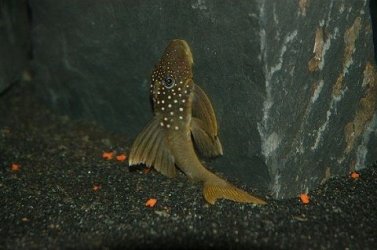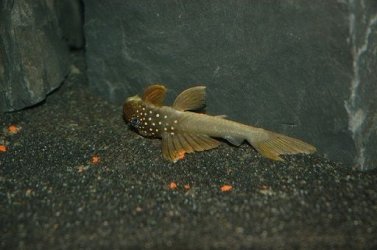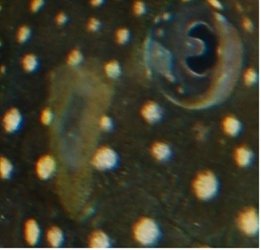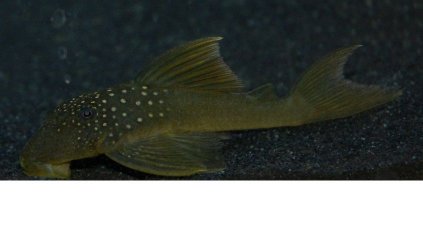triskele
New Member
Tank size: 330 litres
pH: 7.8
ammonia: 0
nitrite: 0
nitrate: 20
kH: no current readings but tap water is fairly hard with a good buffering capacity
gH: 16 dH
tank temp: 78 oF (26 oC)
Fish Symptoms (include full description including lesion, color, location, fish behavior):
Came home late tonight to find one of my L200’s (Green Phantom Plec) on its’ back/side. Its’ breathing appeared to be a bit more rapid than normal (about 50% faster). From level with the dorsal fin down to the caudal peduncle its’ colour appeared to be faded (not completely but enough for me to notice). After a few minutes it righted itself and I noticed a mark/patch on its head. I have included a picture of this below. The patch itself is slightly raised and indented in the middle.
See recent additions for history of the tank.
One of the other L200's also appear to be slightly faded across the same area.
The other tank inhabitants appear to be exhibiting no illness or symptoms at this time.
What I have done so far:
50% water change.
What I am planning on doing tomorrow unless advised differently:
Lower heater setting (aiming for a temperature of 73oF – in case this is bacterial)
Perform another 50% water change.
Remove the carbon from the filter.
Treat with Myxazin (need to buy some when the shops open)
Volume and Frequency of water changes:
Will be between 25% to 50% a week (treated with safe guard)
Chemical Additives or Media in your tank:
Currently running a trickle filter (about 6 times tank volume per hour). Mixture of ceramic media, bioballs and carbon with foam pad pre-filter.
Tank inhabitants:
4 L200 (Green Phantom Plec’s) about 4 inches total length (wild caught and have been in the shop for about 2 weeks).
Pair of Pelvicachromis taeniatus (Niger Red Kribs)
Recent additions to your tank (living or decoration):
The tank is newly set-up (22/12/2012) and was new at purchase. Substrate is aquarium safe dark grey sand (new and rinsed before use) on top of egg crate. Rocks are aquarium safe green slate (new and scrubbed before placing in the tank). One large piece of bog root (new, soaked and scrubbed before placing the tank). Java moss (new and tied to the bog root). 6 pieces of vallis from my other corner tank (no health issues with that tank).
The tank was set up on the 22/12/2012 with the filter running and the temperature allowed to stabilise (Safe Guard used).
On the 24/12/2012 mature ceramic filter media was taken from my second external that was running on my 350 litre corner tank and added to the compartments of the trickle filter.
The inhabitants of this tank were then bought later that day.
Exposure to chemicals:
So far only Safe Guard.
Digital photo (include if possible):
Whole view of sick L200

L200 on its' side

Close up of patch on L200's head

Comparison with another L200 in same tank (this individual currently seems okay)

pH: 7.8
ammonia: 0
nitrite: 0
nitrate: 20
kH: no current readings but tap water is fairly hard with a good buffering capacity
gH: 16 dH
tank temp: 78 oF (26 oC)
Fish Symptoms (include full description including lesion, color, location, fish behavior):
Came home late tonight to find one of my L200’s (Green Phantom Plec) on its’ back/side. Its’ breathing appeared to be a bit more rapid than normal (about 50% faster). From level with the dorsal fin down to the caudal peduncle its’ colour appeared to be faded (not completely but enough for me to notice). After a few minutes it righted itself and I noticed a mark/patch on its head. I have included a picture of this below. The patch itself is slightly raised and indented in the middle.
See recent additions for history of the tank.
One of the other L200's also appear to be slightly faded across the same area.
The other tank inhabitants appear to be exhibiting no illness or symptoms at this time.
What I have done so far:
50% water change.
What I am planning on doing tomorrow unless advised differently:
Lower heater setting (aiming for a temperature of 73oF – in case this is bacterial)
Perform another 50% water change.
Remove the carbon from the filter.
Treat with Myxazin (need to buy some when the shops open)
Volume and Frequency of water changes:
Will be between 25% to 50% a week (treated with safe guard)
Chemical Additives or Media in your tank:
Currently running a trickle filter (about 6 times tank volume per hour). Mixture of ceramic media, bioballs and carbon with foam pad pre-filter.
Tank inhabitants:
4 L200 (Green Phantom Plec’s) about 4 inches total length (wild caught and have been in the shop for about 2 weeks).
Pair of Pelvicachromis taeniatus (Niger Red Kribs)
Recent additions to your tank (living or decoration):
The tank is newly set-up (22/12/2012) and was new at purchase. Substrate is aquarium safe dark grey sand (new and rinsed before use) on top of egg crate. Rocks are aquarium safe green slate (new and scrubbed before placing in the tank). One large piece of bog root (new, soaked and scrubbed before placing the tank). Java moss (new and tied to the bog root). 6 pieces of vallis from my other corner tank (no health issues with that tank).
The tank was set up on the 22/12/2012 with the filter running and the temperature allowed to stabilise (Safe Guard used).
On the 24/12/2012 mature ceramic filter media was taken from my second external that was running on my 350 litre corner tank and added to the compartments of the trickle filter.
The inhabitants of this tank were then bought later that day.
Exposure to chemicals:
So far only Safe Guard.
Digital photo (include if possible):
Whole view of sick L200

L200 on its' side

Close up of patch on L200's head

Comparison with another L200 in same tank (this individual currently seems okay)

